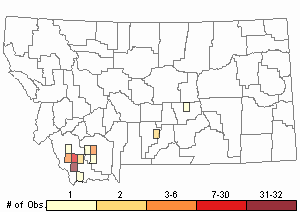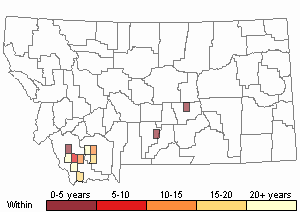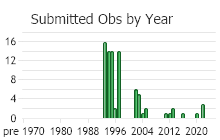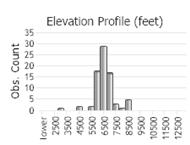View in other NatureServe Network Field Guides
NatureServe
Montana
Utah
Wyoming
Idaho
Wisconsin
British Columbia
South Carolina
Yukon
California
New York
Taper-tip Desert-parsley - Lomatium attenuatum
State Rank Reason (see State Rank above)
Lomatium attenuatum is restricted to northwest Wyoming and southwest Montana, with most of its range in Montana. It is known from several locations in Beaverhead and Madison counties. Some populations may be vulnerable to impacts from mining activities and noxious weed invasion.
- Details on Status Ranking and Review
Population Size
Score1 - Moderate: Generally 10,000-100,000 individuals.
Range Extent
Score2 - Regional or State Endemic or Small Montana Range: Generally restricted to an area <100,000 sq. miles (equivalent to 2/3 the size of Montana or less) or Montana contributes 50% or more of the species’ range or populations OR limited to 2-3 Sub-basins in Montana.
Area of Occupancy
Score2 - Low: Generally occurring in 4-10 Subwatersheds (6th Code HUC’s).
Environmental Specificity
Score1 - Moderate: Species is restricted to a specific habitat that is more widely distributed or to several restricted habitats and is typically dependent upon relatively unaltered, good-quality habitat (C Values of 5-7).
Trends
Score0-1 - Stable to Minor Declines:
CommentTrends are undocumented, but it appears to be unlikely that the species is experiencing significant declines. Habitat is largely intact and undisturbed.
Threats
Score0-1 - Low to Medium.
CommentNo significant or widespread threats are known at this time.
Intrinsic Vulnerability
Score0-1 - Low to Moderate Vulnerability.
Raw Conservation Status Score
Score
6 to 9 total points scored out of a possible 19.
General Description
Taper-tip desert-parsley is a low, herbaceous perennial with stems reaching 7-25 cm in height and bearing 1-2 nearly prostrate leaves on the lower portion. The leaf stalks form a sheath around the stem and the blades are broadly lance-shaped (2-11 cm long) and 3-4 times divided into oblong-linear segments, each 2-5 mm in length. The foliage is roughened like sandpaper. Tiny yellow flowers are borne atop the stems in 5-8 open, umbrella-like clusters with stalks 1-5 cm in length. Each cluster is subtended by up to 6 pointed, linear, inconspicuous bracts, or involucels. Flowers have 5 separate petals atop an ovary that matures into a glabrous, elliptical, flattened fruit 5-8 mm long with corky wings (about. 0.5 mm wide) and a stalk that is 3-10 mm long.
Phenology
Flowering occurs in June and fruits mature in July.
Diagnostic Characteristics
The closely related Lomatium cous has conspicuous elliptic involucel bracts and fruit stalks that are only 1-3 mm long.
Species Range
Montana Range
Range Descriptions

 Native
Native
Range Comments
A regional endemic to the Absaroka Mountains of northwestern Wyoming and the Tendoy Mountains of southwestern Montana.
Observations in Montana Natural Heritage Program Database
Number of Observations: 85
(Click on the following maps and charts to see full sized version)
Map Help and Descriptions
Relative Density

Recency



 (Observations spanning multiple months or years are excluded from time charts)
(Observations spanning multiple months or years are excluded from time charts)
Habitat
The taper-tip desert-parsley grows in scree or dry, gravelly soil of south- or west-facing slopes in mountains, canyons and foothills (Vanderhorst and Heidel 1998). Subsurface horizons often have clay or silt accumulations, or the gravels are perched on shallow bedrock, ameliorating the droughty surface conditions. Most populations are on limestone, but the species has also been found on igneous rock.
In Montana, populations of the species typically occur on dry, unstable, moderate to steep, south- or west-facing slopes in mountains, canyons and foothills (Vanderhorst and Heidel 1998). Its position on the slope varies with substrate conditions. The steepest slopes are in canyons, formed from colluvium of overtowering cliffs. Rock outcrops are present at nearly all sites. A few populations (e.g., near Bannack) extend onto nearly level ridgetops with shallow gravels overlying bedrock. Some large populations extend onto more mesic northern exposures and canyon bottoms or toeslopes.
Soils are generally poorly developed lithosols with a high proportion of gravel, commonly referred to as scree (Vanderhorst and Heidel 1998). The substrates are dry, loose, easily disturbed, and have high water infiltration rates with little or no surface runoff. Surface horizons may be sandy, but subsurface horizons often have clay or silt accumulations, or the gravels are perched on shallow bedrock, ameliorating the droughty surface conditions.
Most populations in the state occur on substrates with limestone parent material but it also grows on igneous substrate in the Tendoy Mountains and Grasshopper Creek and Cold Spring Creek drainages. In Wyoming, this desert-parsley is most often found on volcanics (W. Fertig, personal communication).
Ecological Systems Associated with this Species
- Commonly Associated with these Ecological Systems
Forest and Woodland Systems
Shrubland, Steppe and Savanna Systems
Sparse and Barren Systems
Ecology
A deep, tough rootstock and short period of active growth allow the species to exploit seasonal subsurface moisture, avoid damage from shifting scree, and remain dormant in dry years. Most populations occur on sites with warm, southerly aspects. By mid-summer, the exposed scree is dry and hot, and leaves and stems of the plants are withered. Year to year climatic fluctuations undoubtedly affect seed production, with apparently greater seed production in cool, wet years. In dry years, a high proportion of the plants may remain in a vegetative (non-flowering) state.
Management
In general, the rugged topography and lack of forage in taper-tip desert-parsley habitats minimize direct threats from livestock grazing and other disturbance.
Stewardship Responsibility
Threats or Limiting Factors
STATE THREAT SCORE REASON
Reported threats to Montana's populations of Taper-tip Desert-parsley are currently assigned as unknown (MTNHP Threat Assessment 2021). Spotted Knapweed (Centaurea stoebe), and Cheatgrass (Bromus tectorum) are found at some populations. Information about the severity of impacts to populations is needed to assess its relative risk.
References
- Literature Cited AboveLegend:
 View Online Publication
View Online Publication MTNHP Threat Assessment. 2021. State Threat Score Assignment and Assessment of Reported Threats from 2006 to 2021 for State-listed Vascular Plants. Botany Program, Montana Natural Heritage Program, Helena, Montana.
MTNHP Threat Assessment. 2021. State Threat Score Assignment and Assessment of Reported Threats from 2006 to 2021 for State-listed Vascular Plants. Botany Program, Montana Natural Heritage Program, Helena, Montana.
- Additional ReferencesLegend:
 View Online Publication
View Online Publication
Do you know of a citation we're missing? Clark, T.W., H.A. Harvey, R.D. Dorn, D.L. Genter, and C. Groves (eds). 1989. Rare, sensitive, and threatened species of the greater Yellowstone ecosystem. Northern Rockies Conservation Cooperative, Montana Natural Heritage Program, The Nature Conservancy, and Mountain West Environmental Services. 153 p.
Clark, T.W., H.A. Harvey, R.D. Dorn, D.L. Genter, and C. Groves (eds). 1989. Rare, sensitive, and threatened species of the greater Yellowstone ecosystem. Northern Rockies Conservation Cooperative, Montana Natural Heritage Program, The Nature Conservancy, and Mountain West Environmental Services. 153 p. Heidel, B.L. and J. Vanderhorst. 1996. Sensitive plant species surveys in the Butte District, Beaverhead and Madison Counties. Unpublished report to the Bureau of Land Management. Montana Natural Heritage Program, Helena, Montana.
Heidel, B.L. and J. Vanderhorst. 1996. Sensitive plant species surveys in the Butte District, Beaverhead and Madison Counties. Unpublished report to the Bureau of Land Management. Montana Natural Heritage Program, Helena, Montana. Lesica, P., M.T. Lavin, and P.F. Stickney. 2012. Manual of Montana Vascular Plants. Fort Worth, TX: BRIT Press. viii + 771 p.
Lesica, P., M.T. Lavin, and P.F. Stickney. 2012. Manual of Montana Vascular Plants. Fort Worth, TX: BRIT Press. viii + 771 p. Lesica, P., M.T. Lavin, and P.F. Stickney. 2022. Manual of Montana Vascular Plants, Second Edition. Fort Worth, TX: BRIT Press. viii + 779 p.
Lesica, P., M.T. Lavin, and P.F. Stickney. 2022. Manual of Montana Vascular Plants, Second Edition. Fort Worth, TX: BRIT Press. viii + 779 p. Marriott, H. 1989. Status of Lomatium attenuatum. p. 15, In: Rare, sensitive, and threatened species of the Greater Yellowstone Ecosystem, T. W. Clark, A. H Harvey, R. D. Dorn, D. L. Genter, and C. Groves, eds. Northern Rockies Conservation Cooperative, M
Marriott, H. 1989. Status of Lomatium attenuatum. p. 15, In: Rare, sensitive, and threatened species of the Greater Yellowstone Ecosystem, T. W. Clark, A. H Harvey, R. D. Dorn, D. L. Genter, and C. Groves, eds. Northern Rockies Conservation Cooperative, M Vanderhorst, J., B.L. Heidel, J. Pierce, and S.V. Cooper. 1997. Botanical survey of the Ruby Range, Madison County, Montana. Unpublished report to the Bureau of Land Management Dillon Resource Area. Montana Natural Heritage Program, Helena, MT. 47. pp. plus appendices.
Vanderhorst, J., B.L. Heidel, J. Pierce, and S.V. Cooper. 1997. Botanical survey of the Ruby Range, Madison County, Montana. Unpublished report to the Bureau of Land Management Dillon Resource Area. Montana Natural Heritage Program, Helena, MT. 47. pp. plus appendices. Vanderhorst, J.P. 1995. Survey of Bannack State Park and vicinity for Montana plant species of special concern. Unpublished report to Bannack State Park, Montana Department of Fish, Wildlife, and Parks. Montana Natural Heritage Program, Helena, MT. 43 pp.
Vanderhorst, J.P. 1995. Survey of Bannack State Park and vicinity for Montana plant species of special concern. Unpublished report to Bannack State Park, Montana Department of Fish, Wildlife, and Parks. Montana Natural Heritage Program, Helena, MT. 43 pp. Vanderhorst, J.P. and B.L. Heidel. 1998. Conservation status of Lomatium attenuatum Evert (Apiaceae) in Montana. Unpublished report for the Bureau of Land Management.
Vanderhorst, J.P. and B.L. Heidel. 1998. Conservation status of Lomatium attenuatum Evert (Apiaceae) in Montana. Unpublished report for the Bureau of Land Management. Vanderhorst, J.P. and P. Lesica. 1995a. Sensitive plant survey of the Tendoy Mountains in the Beaverhead National Forest, Beaverhead County, Montana. Unpublished report to the Bureau of Land Management, Butte District. Montana Natural Heritage Program, Helena, MT. 59 pp. plus appendices.
Vanderhorst, J.P. and P. Lesica. 1995a. Sensitive plant survey of the Tendoy Mountains in the Beaverhead National Forest, Beaverhead County, Montana. Unpublished report to the Bureau of Land Management, Butte District. Montana Natural Heritage Program, Helena, MT. 59 pp. plus appendices.
- Web Search Engines for Articles on "Taper-tip Desert-parsley"





